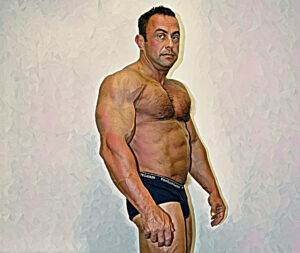
Strength Sensei 101
Rest Intervals
More insights into the pioneering training methods of Charles R. Poliquin
It’s rare to see any published workouts, whether they be for bodybuilding or athletic performance, that prescribe specific rest periods. Whereas methods to increase training intensity often make the cover teasers of fitness magazines, the editors apparently believe that the word “rest” would not entice readers to buy a copy. As the Strength Sensei once said, what can possibly be interesting about doing nothing?
In papers he wrote in the late 80s and early 90s for Canadian and Australian coaching publications, the Strength Sensei wrote that the length of the rest periods influences training in the following ways:
- Regulates the restoration of short-term energy substrates needed for optimal performance. There is training, and there is performance. The amount of rest time taken during training needs to be similar to the amount of rest used in performance at specific times, especially as a season approach.
- Regulates the clearance of metabolic waste that accumulates in the muscle after activity. This factor relates to #1, as the amount of metabolic waste also affects the ability to perform at a high level.
- Influences recovery of the central nervous system after activity. Just because energy substrates are restored and metabolic waste is cleared does not ensure maximum performance. The Strength Sensei used the example of a sprinter performing repeat 100-meter runs. Where a 3-4 minute rest may be enough to prepare for a heavy bench press, a sprinter may need as much as 10 minutes before they can perform another maximal run. (For more on the topic of optimal rest time for sprinters, the Strength Sensei would refer you to the work of Canadian sprint coach Charlie Francis. Several of his books are available on Amazon.com.)
If the goal is developing strength, you want to rest long enough to allow the nervous system to recover nearly completely, not so long as you lose the post-tetanic potentiation effect (PTP). The PTP effect is the phenomenon by which your contraction strength potential will be increased after a heavy set because of greater neural activation.
The Strength Sensei cited the work of German sports scientist Dietmar Schmidtbleicher in the 80s, where he said that the greatest PTP effect occurs around four minutes after an individual performs a near-maximal contraction and begins to decrease after five minutes. However, you also have to consider the type of exercise performed. For example, a squat (compound movement) would require more rest time than a triceps kickback (isolation movement). [The Strength Sensei translated Schmidtbleicher’s work from German, but an excellent overview of his power training methods (including recommendations for rest periods) can be found in a chapter he wrote for Paavo V. Komi’s IOC Medical Commission Publication called Strength and Power in Sport, available through Amazon.com.)
- Influences the metabolic rate and the heart rate after exercise. The metabolic rate after a workout affects how many calories are burned during and even after exercise. In other words, you can burn calories at a higher level after a workout, and the degree and length are influenced by the intensity of the exercise. According to the Strength Sensei, the metabolic rate remains higher for a longer period after a resistance-training workout than an aerobic-training workout. Elevation of heart rate level is also important for cardiovascular fitness.
- Influences hormone secretion as a result of exercise and at what degree The length of a rest period affects growth hormone production (shorter rest for fat loss) or testosterone (longer rest for muscle and strength gains). For example, a workout designed to reduce bodyfat may only have 30 seconds of rest between sets, whereas a workout designed to increase muscle mass may have 90-180 seconds of rest between sets.
 To achieve the highest levels of strength and muscle size requires the appropriate application of rest intervals. (Miloš Šarčev photo)
To achieve the highest levels of strength and muscle size requires the appropriate application of rest intervals. (Miloš Šarčev photo)
When designing workouts, the rest intervals will be influenced by other loading parameters, particularly reps, sets, and tempo. Consider the following relationship between reps, sets, and time under tension (TUT):
Reps Sets TUT Rest Interval
1-3 6 6-18s 240-300s
4-7 5 20-35 180-240
3-5 3 30-50 150-210
8-10 4 48-60 90-180
11+ 3 44+ 90-120
Note that training intensities are not provided, as the Strength Sensei taught that the repetitions should determine the load. However, in the Canadian publication Coaching Review, he wrote that reps of 2-3 generally represented 90-95% of the 1RM; 4-7 reps, 80-89%; 8-10, 75-79%; and more than 11 reps, 75%.
The following example shows how to manipulate rest intervals to develop maximum strength using a superset, allowing four minutes of rest between sets.
A1. Barbell Bench Press, Medium Grip, 5 x 4, 40X1, rest 120 seconds
A2. Bent-Over Barbell Row to Waist, EZ Bar, Supinated Grip, 5 x 4, 4011, rest 120 seconds
Thus, you will be performing 10 sets, broken down like this:
- One set of A1, rest 120 seconds
- One set of A2, rest 120 seconds
- One set of A1, rest 120 seconds
- One set of A2, rest 120 seconds
- One set of A1, rest 120 seconds
- One set of A2, rest 120 seconds
- One set of A1, rest 120 seconds
- One set of A2, rest 120 seconds
- One set of A1, rest 120 seconds
- One set of A2, rest 120 seconds
The advantage of using supersets is that it significantly reduces the total workout time, because as you are working one bodypart you are resting the opposing muscle group. Because the Strength Sensei liked to keep his workouts to about an hour, supersets (along with tri-sets and giant sets) enable him to increase the total volume (amount of work) per training session. He also found that alternating opposing muscle groups (antagonistic pairs) tended to increase motor unit activation.
One last point. The Strength Sensei found that as athletes reach the highest levels of maximal strength, they may be able to accomplish the same goals with shorter rest periods. Another way to say this is that guidelines for rest intervals are just that: Guidelines! (TSS)
